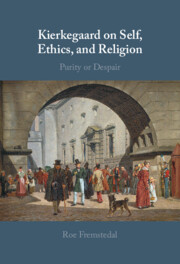Book contents
- Kierkegaard on Self, Ethics, and Religion
- Kierkegaard on Self, Ethics, and Religion
- Copyright page
- Dedication
- Contents
- Figures and Tables
- Acknowledgments
- Abbreviations
- Introduction
- Part I Self, Despair, and Wholeheartedness
- Part II Morality, Prudence, and Religion
- Part III “Subjectivity, Inwardness, Is Truth”
- Part IV Faith and Reason
- Chapter 10 A Leap of Faith? The Use of Lessing, Jacobi, and Kant
- Chapter 11 Faith Neither Absurd Nor Irrational: The Neglected Reply to Eiríksson
- Chapter 12 Faith Beyond Reason: Suprarationalism and Antirationalism
- Chapter 13 The Ethics of Belief: Fideism and Pragmatism
- Conclusion
- References
- Index
Chapter 10 - A Leap of Faith? The Use of Lessing, Jacobi, and Kant
from Part IV - Faith and Reason
Published online by Cambridge University Press: 27 January 2022
- Kierkegaard on Self, Ethics, and Religion
- Kierkegaard on Self, Ethics, and Religion
- Copyright page
- Dedication
- Contents
- Figures and Tables
- Acknowledgments
- Abbreviations
- Introduction
- Part I Self, Despair, and Wholeheartedness
- Part II Morality, Prudence, and Religion
- Part III “Subjectivity, Inwardness, Is Truth”
- Part IV Faith and Reason
- Chapter 10 A Leap of Faith? The Use of Lessing, Jacobi, and Kant
- Chapter 11 Faith Neither Absurd Nor Irrational: The Neglected Reply to Eiríksson
- Chapter 12 Faith Beyond Reason: Suprarationalism and Antirationalism
- Chapter 13 The Ethics of Belief: Fideism and Pragmatism
- Conclusion
- References
- Index
Summary
Chapter 10 shows that Kierkegaard develops his views on faith and reason by using classical German philosophy from Leibniz to Kant. Specifically, he develops the much-discussed category of the leap by making creative use of Jacobi and Lessing. The result is an original account of the leap relevant to both philosophy of religion and more general debates concerning rationality, incommensurability, and noncommensurability. Specifically, the “leap” concerns both general transitions between different normative standards and religious conversions in particular. Even when different standards diverge and conflict, such leaps need not be blind or irrational, if one abandons standards that collapse internally, and the new standards hold up. This general approach allows Kierkegaard to sketch a Kantian reductio of religious nonbelief. However, he appears to follow Schelling in taking Kant’s critique of the ontological argument for God’s existence to show that being is not a predicate, and that thought and being, possibility and actuality, are therefore heterogeneous. Whether or not something exists is then a contingent matter that cannot be known a priori.
- Type
- Chapter
- Information
- Kierkegaard on Self, Ethics, and ReligionPurity or Despair, pp. 173 - 192Publisher: Cambridge University PressPrint publication year: 2022



